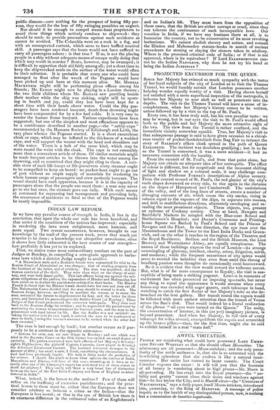PROJECTED EXCURSION FOR THE QUEEN.
SINCE her Majesty has evinced so much sympathy with the tastes of her loyal subjects of the city of London as to visit the Thames Tunnel, we would humbly submit that London possesses another holyday wonder equally worthy of a visit. Having shown herself not satisfied with a mere superficial inspection of the metropolis, it behoves her Majesty to soar aloft as well as penetrate into the depths. The visit to the Thames Tunnel will leave a sense of in- completeness, when her Majesty's history comes to be written, unless followed up by a visit to the top of St. Paul's. Every one, it has been truly said, has his own peculiar taste : we may be wrong, but in our eyes the visit to St. Paul's would afford both to the public and her Majesty the more attractive sight of the two. The view from the Tunnel is rather confined, and the immediate vicinity somewhat squalid. True, her Majesty's visit to that subaqueous passage is said to have given occasion to a chival- rous vender of pocket-hankderchiefs from Rag Fair to reenact the story of RALEIGH'S silken cloak spread in the path of Queen ELIZABETH. The incident was doubtless gratifying ; but in so far as the Tunnel is concerned, it was a mere accident—it had no necessary connexion with the locality.
From the summit of St. Paul's, and from that point alone, her Majesty can obtain an adequate idea of her metropolis. The effect of colour is different, but for magnitude and the incessant shifting of light and shadow on a colossal scale, it may challenge com- parison with Professor FORBES'S descriptions of Alpine scenery. From the central mound of St. Paul's, the red glacier of the city's roofs slopes downward on every side, to rise again in the distance on the slopes of Hampstead and Camberwell. The undulations of the valley, and of the long lines of streets, create a number of diverging currents of air, which cause the city smoke, rising in volume equal to the vapours of the Alps, to separate into masses, and drift in multifarious directions, alternately enveloping and re- vealing the most prominent objects. These objects, too, present an epitome of Cockney society. Close at hand, Newgate and Smithfield Markets lie mingled with the Blue-coat School and Bartholomew's Hospital; and Doctor's Commons and Printing- house Square are flanked by Paul's School and the Prisons of Newgate and the Fleet. In one direction, the eye runs over the IVIansionhouse and the Tower to the East India Docks and Green- wich, and on the other it reaches to the region of the Theatres and the Royal Residence. Bedlam and the British Museum, the Lion Brewery and Westminster Abbey, are equally conspicuous. The names of those buildings express the soul of .London—its strange commingling of gluttony, intellect, charity, crime, litigation, mirth, and madness ; while the frequent occurrence of city spires would seem to remind the beholder that even from amid this throng of headlong passion some thoughts do occasionally steal heavenward.
So it is evident that the view would reward the toilsome ascent. But, what is of far more consequence to Royalty, the visit is sus- ceptible of being made a striking pageant. London in moments of excitement has often presented an imposing spectacle, but never any thing to equal the appearance it would assume when every house-top was crowded with eager gazers, each telescope in hand, watching to catch the first flutter of her Majesty's robe as she de- bouched on the iron gallery. Her transit round the cupola would be followed with more earnest attention than the transit of Venus across the Sun's disk. That would indeed be a literal realization of the phrase "all eyes were turned on the Queen." The unity, the concentration of interest, in this (as yet) imaginary picture, is beyond precedent. And when her Majesty, in full view of every telescope for miles around, emerged from the cupola and scrambled up the brazen pillars—then, for the first time, might she be said to exhibit herself in a real "state ball."


























 Previous page
Previous page